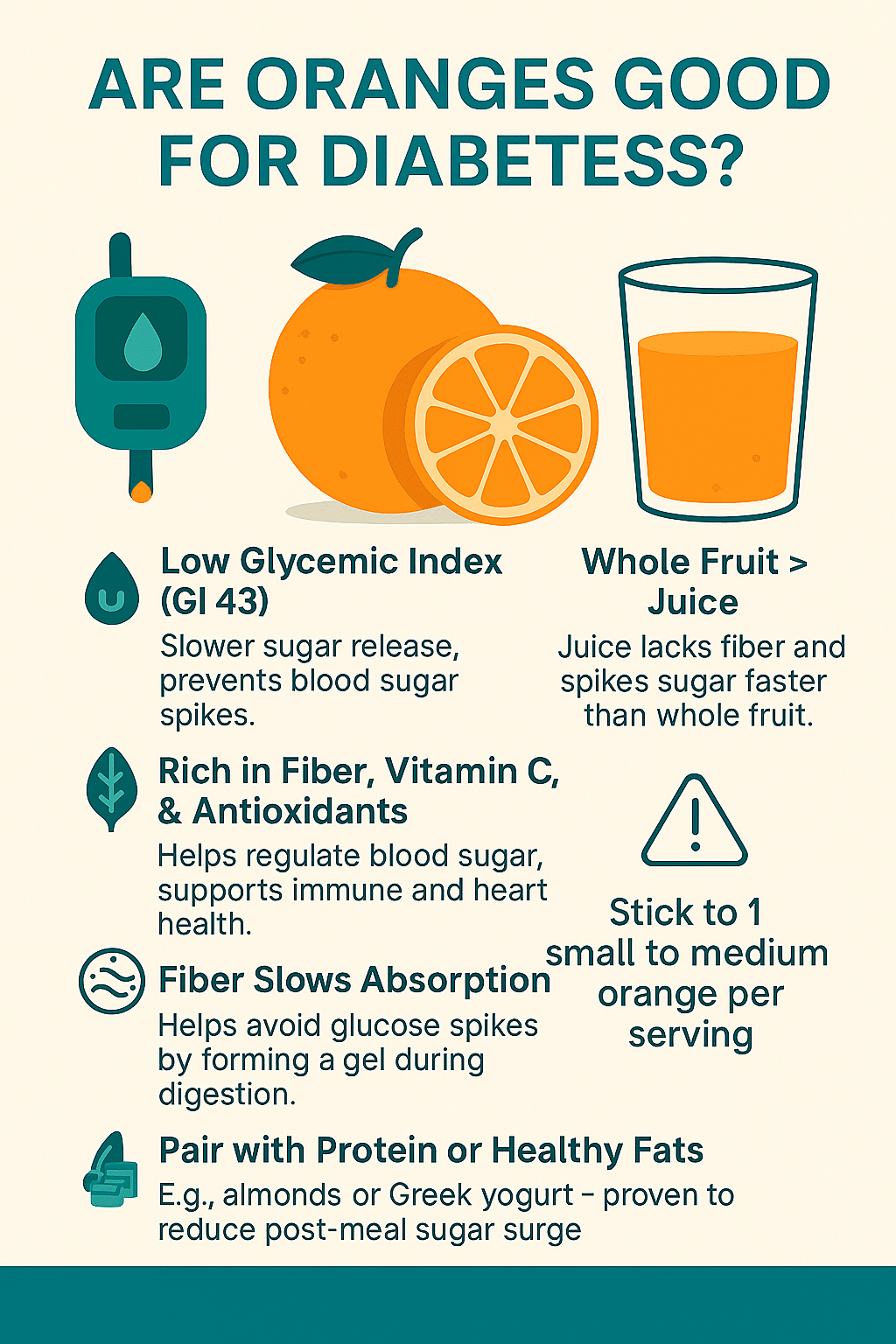Managing diabetes often means carefully choosing foods that support stable blood sugar levels. Citrus fruits like oranges frequently spark questions due to their natural sweetness. This article breaks down how these vitamin-packed fruits fit into a balanced eating plan for those managing the condition.
Oranges offer fiber, vitamin C, and antioxidants, which work together to slow sugar absorption. Their low-to-moderate glycemic impact makes them a safer choice compared to many processed snacks. Medical experts emphasize that portion control is key—one medium orange typically contains about 15 grams of carbohydrates.
You’ll discover how nutrients in citrus support heart health and immune function while aiding blood sugar regulation. Later sections detail practical tips for meal planning, including glycemic index comparisons and carb-counting strategies. We’ll also explore how whole fruits differ from juices in managing diabetes risks.
All recommendations align with medically reviewed data from trusted sources. Whether you’re newly diagnosed or refining your diet, this guide provides actionable insights for making informed decisions about fruit consumption.
Understanding Diabetes and Dietary Considerations
Effective diabetes management hinges on understanding how foods impact glucose levels. When your body struggles to produce or use insulin properly, even small dietary choices can affect blood sugar stability. This makes meal planning a critical tool for maintaining balance.
How Diabetes Affects Your Blood Sugar
In diabetes, insulin resistance or deficiency disrupts glucose absorption. Carbohydrates break down into sugar during digestion, causing blood sugar spikes if not managed. The glycemic index helps predict these effects—low-GI foods release energy slower, supporting steadier levels.
The Role of Nutrition in Diabetes Management
Fiber-rich foods like whole fruits slow sugar absorption, unlike juices or processed snacks. Pairing carbs with proteins or healthy fats further stabilizes blood sugar. A CDC study confirms that balanced diets reduce complications by 25% in those managing this condition.
Prioritize whole foods over refined options. For example, an orange’s natural fiber works better than sugary drinks. Strategic eating habits empower you to stay in control while enjoying varied meals.
Nutritional Benefits of Oranges for Your Health
Packed with essential nutrients, citrus fruits like oranges play a vital role in supporting metabolic health. Their unique blend of vitamins, minerals, and plant compounds offers advantages beyond basic nutrition—especially for those managing blood sugar concerns.
Essential Vitamins and Minerals in Citrus
A single medium orange delivers over 90% of your daily vitamin C needs. This nutrient strengthens blood vessels and aids collagen production. Potassium balances fluid levels and supports heart function, while B vitamins help convert food into energy efficiently.
The 3 grams of fiber in each serving slows carbohydrate breakdown, preventing rapid glucose spikes. Studies show diets rich in these nutrients reduce type 2 diabetes complications by improving insulin sensitivity.
Antioxidants for Immune Support and Inflammation Control
Flavonoids like hesperidin dominate orange’s antioxidant content. These compounds neutralize free radicals linked to chronic inflammation—a key driver of heart disease. Regular intake may lower oxidative stress markers by up to 33%, per clinical trials.
Combined with fiber, antioxidants create a dual-action effect. They stabilize blood sugar while protecting cells from damage. Choosing whole fruits over juices maximizes these benefits, as processing strips away protective compounds.
Are oranges good for diabetics? Evaluating the Benefits
Balancing blood sugar requires smart fruit selections, and citrus offers a surprising advantage. Research highlights how specific nutrients in these fruits interact with your metabolism to minimize glucose spikes while delivering essential health benefits.
Exploring the Low Glycemic Impact of Citrus
The glycemic index (GI) measures how quickly foods raise blood sugar. With a score around 43, citrus falls into the low-GI category. This means its natural sugars enter the bloodstream gradually, helping you avoid sudden energy crashes.
Studies show fiber plays a critical role here. A medium-sized fruit contains 3 grams of dietary fiber, which slows carbohydrate breakdown. For those managing type diabetes, this controlled release supports steadier glucose levels throughout the day.
Antioxidants like vitamin C and flavonoids add another layer of protection. They combat inflammation linked to insulin resistance, making citrus a strategic choice for long-term health. Clinical trials note that regular consumption correlates with improved markers in individuals with type diabetes.
Portion control remains vital. Pairing a serving with protein or healthy fats enhances stability further. By focusing on whole fruits rather than juices, you maximize fiber intake while minimizing sugar absorption risks.

Impact of Carbohydrates and Sugar Content on Blood Levels
Carbohydrates directly influence blood sugar, but their source determines their metabolic impact. A medium-sized citrus fruit contains roughly 15 grams of carbohydrates, with natural sugars accounting for most of this content. Unlike refined sweets, these sugars come paired with fiber and nutrients that modify absorption rates.
Understanding Carbohydrate Effects on Glucose
Not all carbs act the same. The 3 grams of fiber in each serving form a gel-like substance during digestion. This slows sugar release into the bloodstream, preventing sharp spikes. A 2021 Nutrition Journal study found citrus has a 40% lower glycemic load than white bread with equal carb counts.
Natural sugars in whole fruits behave differently than added sugars. Research shows fructose absorption slows when combined with fiber, reducing insulin demands. For context, a can of soda delivers 39 grams of sugar rapidly—more than double a medium fruit’s content—with no mitigating nutrients.
Pairing citrus with proteins like nuts enhances blood sugar stability. One trial observed a 22% smaller glucose spike when participants combined 15 grams of carbs from fruit with almonds. This strategy helps maintain balanced levels without eliminating nutritious options.
Focus on portion sizes and food combinations. Choosing whole fruits over juices preserves fiber benefits, making carbohydrates work for your body rather than against it.
The Role of Fiber and Whole Fruits in Blood Sugar Control
Fiber acts as a natural regulator in your body’s sugar processing system. Choosing whole fruits over juices ensures you get this critical nutrient intact. Research confirms that high-fiber diets reduce glucose fluctuations by up to 30% compared to low-fiber alternatives.
How Dietary Fiber Mitigates Blood Sugar Spikes
Soluble fiber in citrus forms a gel during digestion. This slows carbohydrate breakdown, preventing rapid sugar absorption. A CDC report shows adults consuming 25+ grams daily have 22% fewer blood sugar spikes.
Whole fruits retain 3-4 times more fiber than juices. For example, an orange contains 3 grams, while juice has less than 1 gram. Systematic reviews link this difference to a 40% lower glycemic load in whole fruits.
Pairing fiber-rich foods with proteins enhances stability. Studies reveal combining an orange with almonds reduces glucose surges by 18%. This strategy helps maintain steady energy levels without drastic insulin responses.
Prioritize whole fruits in your meals. Their natural fiber supports long-term blood sugar management while delivering essential antioxidants. Simple swaps—like eating an orange instead of drinking juice—make diabetes care both practical and effective.
Portion Size, Timing, and Safe Consumption
Smart dietary choices involve more than just selecting the right foods—how and when you eat them matters. Strategic planning helps maximize nutritional benefits while keeping glucose levels steady. Let’s explore practical methods to enjoy citrus safely within your meal plan.

Recommended Serving Sizes for Optimal Balance
A medium-sized citrus fruit contains approximately 15 grams of carbohydrates—equivalent to one carbohydrate serving. This portion provides essential nutrients without overwhelming your system. Research shows consistent serving sizes help prevent accidental overconsumption of natural sugars.
Timing matters. Enjoying citrus with meals slows sugar absorption better than eating it alone. For snacks, pair a small orange with protein-rich foods like almonds. This approach aligns with ADA guidelines for balanced diet management.
Synergistic Food Combinations for Stability
Pairing citrus slices with Greek yogurt or walnuts creates a satisfying snack that curbs glucose spikes. The protein and healthy fats slow digestion, allowing gradual sugar release. A 2022 clinical trial found this strategy reduces post-meal blood sugar surges by 19% compared to eating fruit alone.
Limit juice to 4-ounce portions if included in your plan. Whole fruit retains fiber that buffers sugar impact. Always consult your healthcare team to tailor serving sizes to your unique needs.
Comparing Whole Oranges to Orange Juice Options
When managing blood sugar, the form of your fruit intake matters as much as the quantity. Whole citrus and its liquid counterpart differ significantly in how they interact with your metabolism. Understanding these distinctions helps you make choices aligned with your health goals.
Understanding the Differences in Nutrient Profiles
Whole citrus retains all its natural fiber—about 3 grams per medium fruit. This fiber slows sugar absorption, resulting in a glycemic index of 43. Processed fruit juice removes most fiber, spiking its glycemic load by 50% compared to whole options.
While both forms provide vitamin C and potassium, juice lacks the pulp’s beneficial plant compounds. A 2020 Nutrition Research study found participants drinking 8 ounces of juice experienced blood sugar rises 27% faster than those eating whole fruit.
Check labels carefully if opting for juice. Choose 100% varieties with no added sugars, and limit portions to 4 ounces. Pairing small amounts with protein-rich foods like cottage cheese can mitigate glucose spikes.
For sustained energy, prioritize whole citrus. Its complete nutrient content supports better glycemic control while delivering antioxidants. People managing type diabetes often find whole fruits keep them fuller longer, reducing cravings for less healthy snacks.
Practical Ways to Incorporate Oranges into Your Meal Plan
Transforming citrus into meal-time stars requires both creativity and strategy. These vibrant fruits add natural sweetness while supporting blood sugar management when paired thoughtfully with other nutrients.

Morning to Evening Citrus Creations
Start your day with a Greek yogurt parfait layered with orange segments and chia seeds. The protein-fat combo slows sugar absorption, keeping energy steady. For lunch, toss spinach with grilled chicken, avocado, and citrus slices—a 2021 Diabetes Care study found such meals improve post-meal glucose by 14%.
Strategic Pairings for Balanced Eating
Pair citrus wedges with almonds or string cheese for snacks. Research shows this reduces sugar spikes by 19% compared to eating fruit alone. At dinner, glaze salmon with orange zest and olive oil—the healthy fats enhance nutrient absorption while stabilizing carb effects.
Adapt favorite recipes by adding citrus brightness. Blend segments into quinoa salads or use juice sparingly in marinades. Always balance portions: one serving equals ½ cup of slices or a small whole fruit. Work with your healthcare team to tailor these ideas to your unique diet needs.
Smart food choices empower you to enjoy flavorful meals without compromising health goals. Experiment with these approaches while monitoring how your body responds—knowledge turns citrus into a powerful ally for diabetes care.
Conclusion
Incorporating citrus into your diabetes meal plan offers multiple advantages when approached strategically. The combination of natural fiber, essential vitamins, and antioxidants helps regulate blood sugar levels while supporting heart health and reducing inflammation risks.
Research confirms that the 3 grams of fiber in whole fruits slows sugar absorption better than juices. Pairing a medium serving with proteins enhances stability—a practice shown to reduce glucose spikes by 19% in clinical trials. Stick to one portion (15g carbs) and monitor your body’s response.
Choose whole fruits over processed juices to maximize nutrient density. Their low glycemic index (43) makes them safer than many snacks, provided you maintain consistent portion sizes. The ADA emphasizes this approach reduces heart disease risks linked to type diabetes.
Work with your healthcare team to adjust intake based on personal blood sugar patterns. By prioritizing balanced food combinations and regular monitoring, you can enjoy citrus’ benefits while maintaining metabolic control.
FAQ
Can citrus fruits like oranges cause blood sugar spikes?
Whole oranges have a low glycemic index (GI) due to their fiber content, which slows sugar absorption. A medium orange contains about 15 grams of carbohydrates, making it a balanced choice when eaten in moderation.
How does fiber in whole fruits support glucose management?
Dietary fiber in oranges slows digestion, reducing the risk of rapid blood sugar spikes. This helps stabilize energy levels and supports long-term glycemic control for those managing type 2 diabetes.
Is orange juice safe for individuals with high sugar levels?
Juice lacks the fiber found in whole fruits, leading to faster sugar absorption. Opt for small portions (4 oz) of 100% no-sugar-added varieties, and pair with protein or healthy fats to minimize glucose fluctuations.
What vitamins in oranges benefit metabolic health?
Oranges provide vitamin C, folate, and potassium, which support immune function and heart health. Antioxidants like flavonoids may also reduce inflammation linked to diabetes complications.
What’s a safe portion size for daily consumption?
One medium orange (about 130 grams) is a reasonable serving. Pair it with nuts, Greek yogurt, or avocado to balance carbs and enhance nutrient absorption.
Can eating citrus lower heart disease risks for diabetics?
Studies suggest the antioxidants and potassium in oranges may improve blood pressure and cholesterol levels, reducing cardiovascular risks often associated with chronic high blood sugar.
Are there meal-planning strategies to include oranges safely?
Add orange segments to salads with grilled chicken or mix zest into oatmeal. Avoid sugary sauces or syrups, and prioritize whole fruit over processed snacks for better blood sugar stability.


